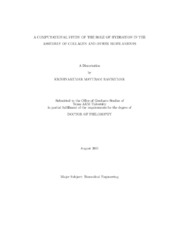A Computational Study of the Role of Hydration in the Assembly of Collagen and Other Bio laments
Abstract
Hydration is known to be crucial in biomolecular interactions including ligand binding and self-assembly. In our earlier studies we have shown the key role of water in stabilizing the specific parts of the collagen triple helix depending on the imino acid content. We further showed that the primary hydration shell around collagen could act as a lubricating layer aiding in collagen assembly. But key details on the structure and dynamics of water near protein surfaces and its role in protein-protein interactions remain unclear. In the current study we have developed a novel method to analyze hydration maps around peptides at 1-A resolution around three self-assembling lament systems with known structures, that respectively have hydrated (collagen), dry non-polar and dry polar (amyloid) interfaces. Using computer simulations, we calculate local hydration maps and hydration forces. We find that the primary hydration shells are formed all over the surface, regardless of the types of the underlying amino acids. The weakly oscillating hydration force arises from coalescence and depletion of hydration shells as two laments approach, whereas local water diffusion, orientation, or hydrogen bonding events have no direct effect. Hydration forces between hydrated, polar, and non-polar interfaces differ in the amplitude and phase of the oscillation relative to the equilibrium surface separation. Therefore, water-mediated interactions between these protein surfaces ranging in character from ‘hydrophobic’ to ‘hydrophilic,’ have a common molecular origin based on the robustly formed hydration shells, which is likely applicable to a broad range of biomolecular assemblies whose interfacial geometry is similar in length scale to those of the present study.
In a related study through simulations we show that the rate of tissue optical clearing by chemical agents correlated with the preferential formation of hydrogen bond bridges between agent and collagen. Hydrogen bond bridge formation disrupts the collagen hydration layer and facilitates replacement by a chemical agent to destabilize the tertiary structure of collagens thereby reducing light scattering. This study suggests that the clearing ability of an alcohol not only depends on its molecular size, but also on the position of hydroxyl groups on its backbone.
Subject
collagenhydration
self-assembly
amyloid beta sheets
surface water properties
water
surface physics
intermolecular forces
Citation
Mayuram Ravikumar, Krishnakumar (2011). A Computational Study of the Role of Hydration in the Assembly of Collagen and Other Bio laments. Doctoral dissertation, Texas A&M University. Available electronically from https : / /hdl .handle .net /1969 .1 /ETD -TAMU -2011 -08 -9908.


